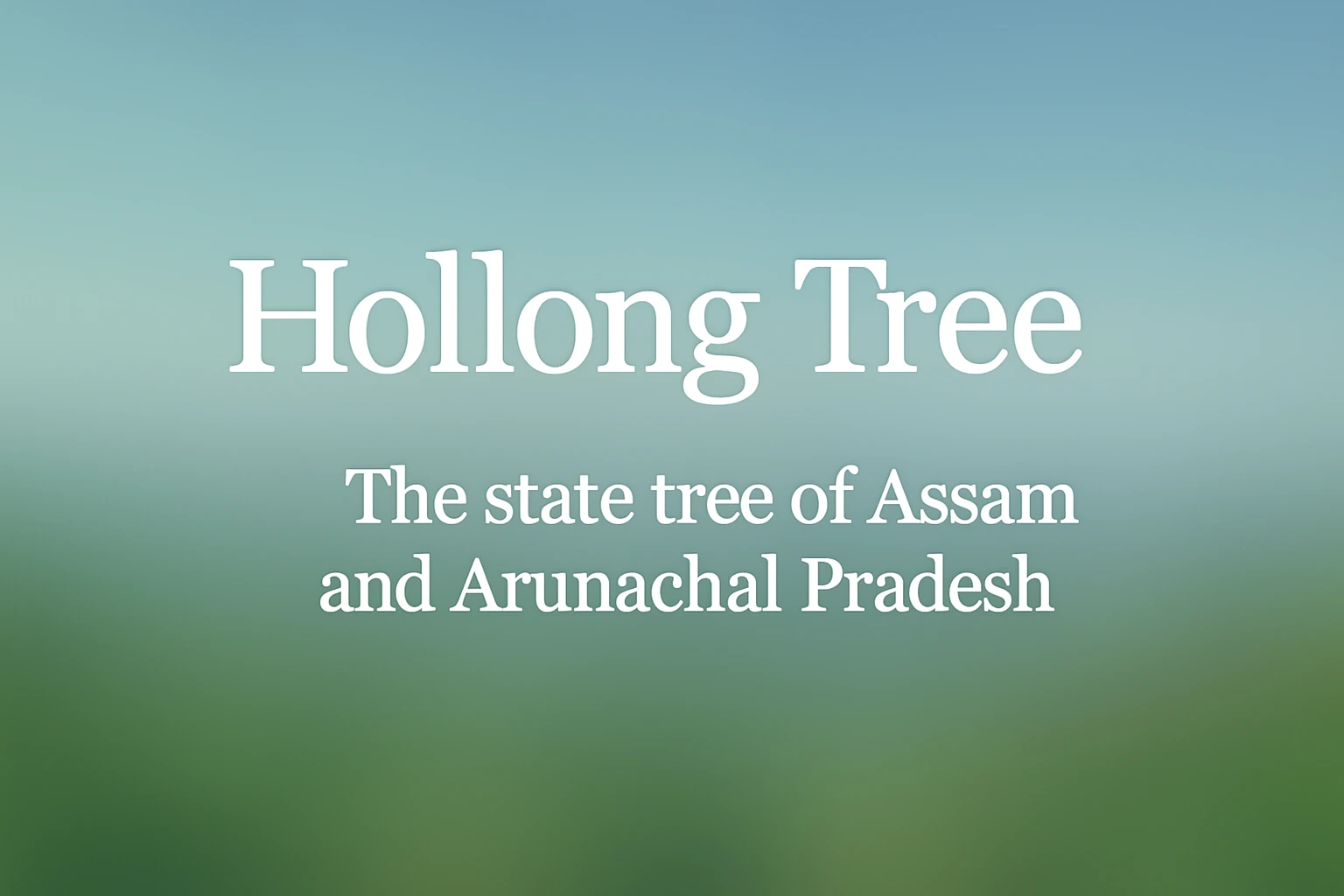The Hollong tree, scientifically known as Dipterocarpus macrocarpus (also Dipterocarpus retusus), is a magnificent hardwood species native to the lush tropical forests of Northeast India and Southeast Asia. Revered as the state tree of Assam and Arunachal Pradesh, the Hollong tree is a symbol of ecological richness, cultural heritage, and economic importance.
Botanical Description and Characteristics
The Hollong tree is a towering giant that can grow up to 40 to 60 meters in height. It features a tall, straight cylindrical trunk, often free of branches for 15 to 20 meters, crowned by a small spherical canopy. The bark is reddish-brown and smooth, while its large, glossy, leathery leaves are ovate to elliptical in shape with prominent veins.
The tree blooms with pink to purple bell-shaped flowers arranged in clusters, followed by distinctive winged fruits (samara), which aid in wind dispersal. Due to its impressive stature and strength, the Hollong is sometimes called the tallest tree species in Assam and Arunachal Pradesh.
Ecological Role
As a keystone species in tropical forests, the Hollong tree plays a vital role in maintaining forest ecosystem balance. It provides habitat and sustenance for a diverse array of wildlife species, including birds, mammals, and insects. Its deep root system helps prevent soil erosion, while the tree significantly contributes to carbon sequestration, absorbing vast amounts of carbon dioxide and aiding in climate regulation.
Also read: Maniram Dewan: The Father of Assam Tea and Pioneering Freedom Fighter
The dense forests dominated by Hollong and related Dipterocarpus species contribute immensely to biodiversity preservation, watershed protection, and global carbon cycling.
Economic and Cultural Importance
The timber of Hollong is highly valued for its strength, durability, and resistance to pests and decay. It is extensively used in construction, furniture making, plywood manufacturing, boat building, and various woodworking applications. The tree’s resin, extracted from wounds in its bark, is utilized in varnishes, paints, waterproofing, and traditional medicine.
Indigenous communities in Northeast India also regard the Hollong tree as sacred. It holds a special place in folklore, rituals, and cultural practices, symbolizing strength, longevity, and harmony with nature. The tree is sometimes used as fuelwood, insect repellent, and for extracting oleoresins serving as lubricants.
Conservation Challenges
Despite its significance, the Hollong tree faces threats due to habitat loss, illegal logging, and deforestation. Conservation efforts and sustainable forest management practices are essential to protect this majestic species and ensure the survival of the rich ecosystems it supports.
Cultivation and Growth Conditions
Hollong grows best in tropical climates with annual rainfall around 3000 mm and temperatures ranging from 22 to 30°C. It thrives in well-drained soil with elevations between 100 to 1300 meters. Due to its fast growth and economic value, the tree is often planted for afforestation and commercial timber production.
Summary
The Hollong tree (Dipterocarpus macrocarpus) is a vital part of the natural, economic, and cultural landscape of Northeast India. Its towering presence, ecological functions, and multipurpose uses make it an iconic species worth conserving and promoting for future generations.
Multiple Choice Questions (MCQs) on Hollong Tree
Q1. What is the botanical name of the Hollong tree?
a) Shorea robusta
b) Dipterocarpus macrocarpus
c) Terminalia catappa
d) Tectona grandis
Answer: b) Dipterocarpus macrocarpus
Q2. Which Indian states have the Hollong tree as their state tree?
a) Assam and Arunachal Pradesh
b) Meghalaya and Nagaland
c) Karnataka and Kerala
d) Rajasthan and Gujarat
Answer: a) Assam and Arunachal Pradesh
Q3. What is the typical height range of a mature Hollong tree?
a) 10-20 meters
b) 20-30 meters
c) 40-60 meters
d) 70-90 meters
Answer: c) 40-60 meters
Q4. The timber of the Hollong tree is primarily used for:
a) Paper production
b) Construction and plywood
c) Fuel only
d) Ornamentals
Answer: b) Construction and plywood
Q5. Which ecological role is NOT associated with the Hollong tree?
a) Wildlife habitat
b) Soil erosion control
c) Carbon sequestration
d) Desertification enhancer
Answer: d) Desertification enhancer
Q6. The Hollong tree thrives best in:
a) Dry and arid regions
b) Cold mountainous areas
c) Warm, humid tropical forests
d) Urban city parks
Answer: c) Warm, humid tropical forests
Frequently Asked Questions (FAQs) about Hollong Tree
Q1. What is a Hollong tree?
The Hollong tree, scientifically known as Dipterocarpus macrocarpus, is a large hardwood tree native to Southeast Asia, particularly Northeast India. It is renowned for its tall stature and high-quality timber.
Q2. Where is the Hollong tree commonly found?
Hollong trees grow naturally in tropical and subtropical forests of India (Assam and Arunachal Pradesh), Myanmar, Thailand, Laos, and other Southeast Asian countries.
Q3. How tall can a Hollong tree grow?
The tree can reach heights of 40 to 60 meters, with a straight cylindrical trunk that can be branchless up to 15-20 meters.
Q4. What are the uses of the Hollong tree?
Hollong timber is used for construction, plywood, furniture, and boat building. The tree’s resin is used in varnishes and traditional medicine.
Q5. Why is the Hollong tree important ecologically?
It plays a vital role in forest ecosystems by supporting biodiversity, providing wildlife habitat, preventing soil erosion, and contributing to carbon sequestration.
Q6. What climate does the Hollong tree prefer?
It thrives in warm, humid tropical climates with rainfall around 3000 mm annually and temperatures ranging from 22°C to 30°C.
Q7. Is the Hollong tree culturally significant?
Yes, in Assam and Arunachal Pradesh, it is considered sacred by indigenous communities and featured in local folklore and rituals.
Q8. Can the Hollong tree be grown in plantations?
Yes, it can be cultivated in plantations for sustainable timber harvesting and forest conservation.

